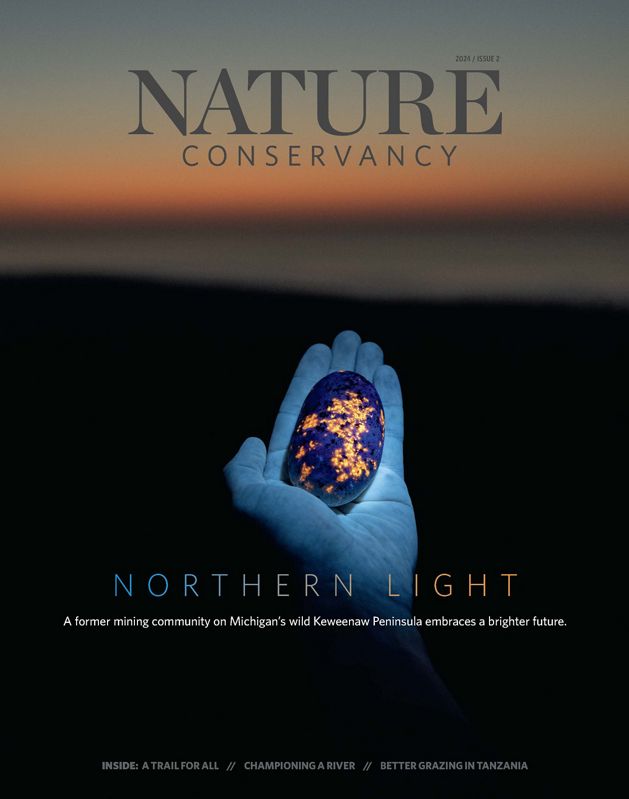Mongolia’s New Horizon
Faced with a changing climate and challenges to its citizens’ livelihoods, the country has committed to conservation.

Alabama’s waterways conceal hidden worlds that are ancient, biodiverse and increasingly at risk.
Text by Lindsey Liles | Photographs by Mac Stone | Issue 4, 2025
Outfitted with a snorkel and goggles, Ben Wegleitner dips his head underwater in Turkey Creek outside of Birmingham, Alabama, and pulls himself against the current in the 2-foot-deep water. Every so often, he surfaces to name the species he spots—an Alabama hog sucker, poking through leaf litter; a federally endangered rush darter, propped on its fins and resting; an Alabama shiner, a silvery blue flash among the rocks. Wegleitner is The Nature Conservancy’s urban watershed restoration specialist in Alabama and part of the team that helps protect these and hundreds of other rare species.
Most people don’t know it, but Alabama is a global hot spot for freshwater biodiversity. The density and variety of its life—and the work being done to protect it—starts in the southern Appalachian Mountains, the source of much of its water, and continues all the way down the state, following the flow across thousands of miles of waterways that run all the way to Mobile Bay.


This map of Alabama shows large networks of rivers and their location in proximity to the cities of Birmingham, Montgomery, and Mobile. In particular, the Cahaba River watershed, the Mobile-Tensaw River Delta, and Mobile Bay are highlighted.
Turkey Creek is cold even in the dead of summer. It’s part of the Black Warrior watershed, which is fed by mountain springs and streams, and supports its own set of unique, endemic life. Alabama is full of waterways like this, in total hosting more than 300 species of freshwater fish, 186 species of mussels, 31 species of turtles, 97 species of crayfish and 202 species of freshwater snails. But with around 100 extinctions (mostly of mussels and snail species) since colonial times, Alabama is one of the country’s leaders in losing its native wildlife. That makes TNC’s work to protect this expansive underwater world both vital and urgent.
As a whole, Alabama’s river systems are damaged and disconnected, says Jason Throneberry, TNC’s director of Alabama freshwater programs. In addition to pollution, sedimentation and development, thousands of dams disrupt the connectivity of the more than 132,000 miles of streams and rivers in the state, requiring TNC to take a landscape-scale approach to bypass or remove dams and restore connectivity.




“What we do up here in the headwaters around Birmingham impacts everything on down,” Wegleitner says. He and his colleague Alana Reynolds, a watershed coordinator at TNC, manage and work with partners on stream-bank protection and restoration projects that reduce the amount of sediment reaching the water. And they work with cities and private landowners to protect highly sensitive and localized species, like the federally endangered watercress darter, which has only a few remaining strongholds; one is on a golf course.
The water travels two main pathways down to the Gulf—the Alabama and the Tombigbee rivers. Life abounds in the tributaries. In the Cahaba River, for example—the state’s longest free-flowing river—a rare white lily blooms and prehistoric alligator snapping turtles ambush their prey. The Nature Conservancy has created three preserves along this Alabama River tributary, plus teamed up with state and federal agencies to create the Cahaba River National Wildlife Refuge.




“There is this whole cascade of interconnected life,” says Throneberry. A self-identifying “river hippie and fish guy,” Throneberry spends hours on his boat, conducting both on-the-ground restoration and survey work, and landscape-level planning: He’s working to identify key dams that block animals’ passage and planning for how connectivity can be restored for all the species that need it, including mussels, whose larvae travel and disperse on the gills of host fish. His favorite place is the Mobile-Tensaw Delta, where the Alabama and Tombigbee rivers meet.
This delta is threaded by streams and home to towering cypress trees, alligators, fish and turtles like the Alabama red-bellied cooter. “This is the nexus for all these migratory species that we want to get back running up the rivers, too, like sturgeon and mullet,” Throneberry says, “a key piece of the puzzle.” The Nature Conservancy scored a major win here in February 2024 when it acquired nearly 8,000 acres in the heart of the delta. It has been named the E.O. Wilson Land Between the Rivers Preserve, after the legendary conservationist and Alabama native.


After passing through the delta, the water flows into the saltwater estuaries of Mobile Bay. Here, TNC’s Assistant Coastal Programs Director Mary Kate Brown leads and coordinates projects with partners like the National Oceanic and Atmospheric Administration and the National Fish and Wildlife Foundation to restore eroding shorelines and barrier islands, protecting key rookeries for nesting migratory seabirds and boosting coastal resilience.
From 1,000 feet up in a single-engine airplane, the barrier islands and Mobile Bay give way to the delta, a low-slung forest laced with serpentine waterways. Three egrets glide above the Alabama River, their flight path mirroring the bends of the water below. The birds fly north, where the delta rises into the uplands, and eventually on to the rolling foothills of the Appalachians and Turkey Creek with its colorful host of fish. This freshwater system is a mosaic of hidden life—delicate yet resilient, and ours to protect.
“Alabama is the epicenter of aquatic biodiversity in North America. The turtles, the fish, the crayfish, the mussels—this is the only place in the world where they can live and thrive,” says Throneberry. “The time to act is now.”
Lindsey Liles is a freelance journalist and editor for Garden & Gun magazine based in South Carolina.
Mac Stone is a conservation photographer based in South Carolina. His work has been published in National Geographic magazine and other publications.

Sign up for the Nature News email and receive conservation stories each month.